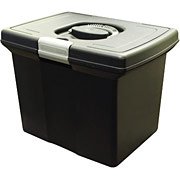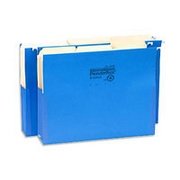
File Organization From Your Car
A Portable Document Filing System
Perfect For Those Working From Their Vehicles
by L. Kenway BComm CPB Retired
Quick Links
- What You Need and How To Organize It
- How To Organize Your Home Office To Accommodate This System
- Benefits Of This System
File organization is key to running your business efficiently and ensuring you get all the tax deductions you are entitled to.
If you aren't using any of the cloud apps to organize your receipts and paperwork, this portable paper-based document filing system is perfect for those of you who operate a part of your business from your vehicle such as landscapers and lawn maintenance businesses, home repair contractors, chimney sweeps, travelling disc jockies ... you get the idea.
Incorporate it into your home office organization and small business accounting system to manage your business receipts efficiently.
This portable document filing system will create streamlined file organization so you have all your information available at your fingertips.
This simple filing system will help you get your business receipts organized ... and keep them organized effortlessly. Audits should go smoothly and your accountant will love you at year-end too!
Advertisements
|
|
|
File Organization - Here's What You Need

- Buy a letter size plastic file caddy with a handle (so you can tote it about easily) from an office supply store like Staples. It should cost about $15-20.
- Keep a pen, a pencil (for writing in winter time), some paper clips and a letter opener in your caddy.
- Place eight hanging folders with tabs inside the caddy.
- Sort eighteen file folders or hanging box file folders behind each section as directed below. The color suggestion for each section is listed in brackets below.
- One plastic sleeve for your Chart of Accounts.
- Label the eight tabs. Behind each tab, place the suggested file folders.
- Expense Receipts (red) This section is sorted by payment type.
- Chart of Accounts so you can code your invoices and expense receipts before you file them. Place it in the plastic sleeve just behind the tab for easy access.
- Banking Transactions/Receipts including your personal draws here along with other bank transactions.
- Credit Cards Transactions/Receipts
- Cash Transactions/Receipts
- Expense Reports/Receipts for purchases made from your personal funds. Keep some blank expense report forms filed here for easy access.
- Unpaid Bills
- Permanent Records (purple)
- Purchase and Sale of Capital Assets
- Financial Loans/Insurance/Contracts
- Monthly Financial Reporting Package (manilla) See month end procedures - items 15 and 18 for the reporting package details.
- Government Paperwork (yellow) There is no need to sort it here. You will do that later in your office.
- Payroll (blue) There is no need to sort it here. You will do that later in your office.
- Statements for Reconciliation (orange) This section is sorted by type of reconciliation.
- Bank Statements (including deposit slips)
- Credit Card Statements (including payment slips)
- Vendor Statements
- Revenues (green) If you have more than one sales account, use your Chart of Accounts to code the invoices/receipts before you file them.
- Customer Invoices
- Sales Receipts
- Outstanding Customer Invoices
- Money Collected/Received
- The money will get deposited after it has been processed in the office. If it is for an outstanding invoice, pull the invoice and clip the payment to it before slipping it into the folder.
- Mail if it is not delivered to your home and you have to drive to go pick it up.
 File Organization Suggestion: You may want to use hanging box file folders instead of regular file folders so that you don't lose any small bits of paper as you take the folders in and out of the file caddy to do your data entry.
File Organization Suggestion: You may want to use hanging box file folders instead of regular file folders so that you don't lose any small bits of paper as you take the folders in and out of the file caddy to do your data entry.
File Organization - Here's What To Do
|
For this file organization system to work, you must keep the file caddy in your vehicle with you. As you go through the day, instead of chucking receipts onto the floor of your vehicle … or stashing them in the glove compartment, side door pocket, or purse … take a second to code the expense receipt or sales invoice using your Chart of Accounts ... then open the caddy and place the receipt in the appropriate file folder. |
 |
Do the same thing when you open your mail … drop it into the appropriate file in your caddy as soon as you open it. If the mail doesn't pertain to bookkeeping, then leave it in the Mail section to deal with later back in your office.
If you hand write sales receipts (you receive payment on the spot) or invoices (the customer will pay you later), put your copy in the alloted file folder. These documents should always be on pre-numbered forms.
The caddy now holds all of your unprocessed paperwork … nicely organized, coded for data processing, and easy to locate with no effort.
File Organization
5 Receipts Tips
Each night, write up your bank deposit slip for the money you received that day so you can deposit it in the bank the following day. Your cash flow is important so don't put this task off.
Once a week or month (the timing depends on your routine and the amount of transactions you have), bring your caddy into your office, and process each piece of paper you collected. Make sure you stamp it with an “entered” or “posted” stamp so you know you’ve entered the work into your books.
You may want to consider moving to paperless technology to process your work. You will need to organize your paperless workflow a bit differently. If you decide to scan, you still need to keep your original receipts in the event of a CRA audit.
After you have processed your work, file it into the office filing cabinet in the appropriate spot. Your file organization becomes effortless and habitual if you use it every day of the year.
Please don't keep more than one month's receipts in the caddy. Make sure you file the processed documents in your home office. The reason is to prevent loss of your source documents due to a car accident or vehicle theft. Hey .. it happens unfortunately.
Here's Your Home Office Organization
For your home office organization, your office filing cabinet should be organized as follows:

- Financial Reports (manilla file folders) - will hold all of your monthly reporting packages … except the current one which is in your caddy so that you can reference it throughout the month if you need to.
- Permanent File (purple file folders)- will hold copies of all of your processed capital transactions along with all of your financial and contractual obligations.
- Government Correspondence (yellow file folders) - will hold all your forms/reports that have been submitted to any level of government. Have a file folder for each type of tax.
- Bank Statements (orange file folders) - will hold all of your reconciled bank statements, reconciliation reports, and cheque images. If you have more than one bank account, you can have a folder for each one OR you can place all of them together into monthly file folders ... one folder for each month in the year.
- Credit Card Statements (orange file folders) - will hold all of your reconciled credit card statements and reconciliation reports. If you have more than one credit card, you can have a folder for each one OR you can place all of them together into monthly file folders ... one folder for each month in the year.
- Payroll (blue file folders) - will hold all of your processed payroll information by employee name ... include copies of the pay cheques.
- Sales Transactions (green file folders) - will hold all your paid customer invoices in numerical order. If you also have processed sales receipts, they should have their own folder as well.Any outstanding invoices will stay in your caddy in the Outstanding Customer Invoices folder. They should have an "Entered" stamp to show you have already input them into your accounts receivable. You may also want to print out a new aged Accounts Receivable report to put in the caddy.
- Expenses (red file folders) - will hold all your processed expense receipts, one file folder for each month OR filed alphabetically by vendor … your choice … it depends how often you have to look up invoices. Personally, as a small business doesn’t have a lot of transactions, I prefer to file by month as it is quicker to file. I can always look up the details of an invoice by vendor in my accounting system without touching a piece of paper.
- Paperclip all your small receipts together so they don't get lost, or consider slipping them into a small envelope before you place them into the file folder.
- Any unpaid bills will stay in your caddy in the Unpaid Bills folder. They should have an "Entered" stamp to show you have already input them into your accounts payable. You may also want to print out a new aged Accounts Payable report to put in the caddy.
If you ever need to pull out a piece of paper work for some reason, have blanks forms at the front of your filing cabinet that you can fill out (i) what was taken, (ii) who took it and (iii) when. Put the slip in the same spot where the paperwork was removed. When you file it back, remove the reminder form. Your file organization remains intact.
If you are going paperless, then part of your processing routine will include scanning all your paperwork into your computer once it has been processed.

Your home office organization is simple ... keep two years of files in your office - current year in the higher drawers and prior year in the lower drawers.
At the end of each year:
- Remove and box the prior year file drawers . Place it in storage.
- Move your current year files (excluding the Permanent File, leave it in your current filing drawer) into the prior year file drawers.
- Setup the current year file drawers.
This way your office space stays clean and tidy … and you don’t run out of office filing cabinet space.
Benefits of File Organization in the Long Run
If you are audited, you just have to pull out your boxed file … everything the auditor needs should be there … as long as you haven’t gone in and taken out pieces of paper and not returned them.
The auditor will love your file organization! Just remember, never let the auditor take original source documents, always make a copy of anything needed for their files.
If your accountant prepares your financial statements and tax return at year-end, it will be easy to copy the documents required, leaving the rest in the prior year filing drawer.
If you have gone paperless, you can put the required information/reports on a CD for your accountant to use.
Your accountant will love your file organization! Just remember, never let your accountant take original source documents, always make a copy of anything needed for their files.
This portable document filing system is a simple and effective way to keep organized all year long.
File organization doesn't have to be a chore ... done right, it's almost like breathing ... you aren't even aware you are doing it. ;o)
